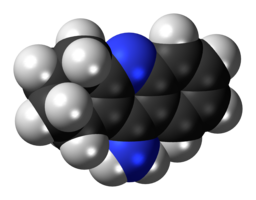Tacrine derivatives as a potent and selective GLU2b antagonist for treatment of neuropsychiatric diseases II
INTRODUCTION:
The continuous research in the field of Alzheimer’s disease (AD) has contributed to delineate this disease as a multifactorial syndrome with several biological targets involved in its etiology. Thus the curative paradigm of one-compound one-target that has been followed so far has not reached the desired expectations.
TECHNOLOGY (INVENTION) DESCRIPTION:
Our goal was to develop a multi-target-directed ligand (MTDL) combining the support for the cholinergic system by inhibition of acetylcholinesterase (AChE) and at the same time ameliorating the burden caused by glutamate excitotoxicity mediated by the NMDA receptors. We have developed a derivative based on tacrine scaffold, which is a potent inhibitor of acetylcholinesterase and a selective and potent inhibitor of the GluN1/GLuN2B receptors. The mechanism of binding to the GluN1/GLuN2B receptors has showed that it binds to the ifenprodil – binding site, in addition to the pore region of the GluN1/GluN2B receptors. Together, our data shows that tacrine derivative inhibits the GluN1/ GluN2B receptors by a voltage-independent manner.
ADVANTAGES OVER EXISTING SOLUTIONS:
Our structures are multi-targeted hybrids based on tacrine structure scaffold. While currently used treatment consists of memantine (NMDA blocker) and AChE inhibitors, we combined both approaches in the single molecules. Our data suggests efficacy on both targets, with favourable drug-like properties (solubility, absorbtion, BBB permeability). The neuroprotective ability of the compounds to prevent or treat neuronal damage caused by the NMDAr overstimulation was confirmed by the permanent lesion of hippocampus induced by a microinjection of NMDA. We also confirmed that the compound crosses the blood-brain barrier with the plasma brain ration apprx. 1/3.
DEVELOPMENT STATUS (STAGE):
preclinical, animal models
PUBLICATIONS:
We published only previously synthetised compounds e.g.: doi: 10.1016/j.ejmech.2018.02.083 doi: 10.2174/1567205015666180711110750 doi: 10.3390/molecules22061006 doi: 10.1016/j.ejmech.2016.12.048 doi: 10.1016/j.jinorgbio.2016.05.001
IP PROTECTION STATUS:
no patent applications, new structures were not published
TECHNOLOGY / IP OWNERS :
National Institute of Mental Health, University Hospital Hradec Kralove

More information
More information is available upon signing a CDA / NDA (Confidential Disclosure Agreement / Non-Disclosure Agreement)